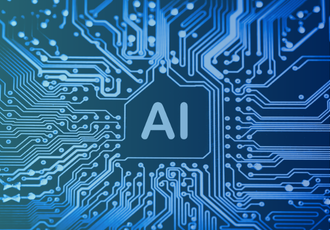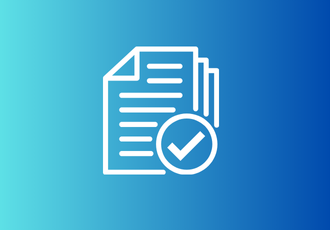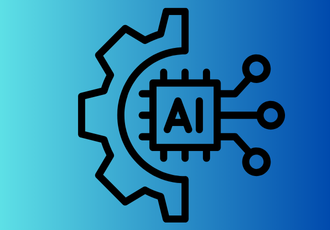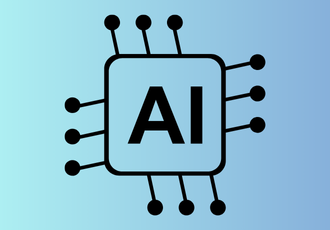AI has become crucial for organizations looking to automate their key operations, and make them faster, more accurate, and cost-effective.
According to a report by Accenture, 69% of executives recognize an urgent need to move beyond simple automation and adopt AI-driven transformations at the core of their business processes.
But how exactly does AI process automation work, and what tools should businesses use? This guide breaks it all down—trends, use cases, and the best AI automation tools to streamline workflows. Let’s get into it.
What is AI Process Automation?
AI process automation leverages artificial intelligence to automate repetitive, rule-based tasks. By combining machine learning (ML), natural language processing (NLP), and process automation, it can handle unstructured data, identify patterns, and make smart, data-driven decisions.
AI-powered automation learns, adapts, and can make data-based decisions. With the introduction of agentic AI, process automation is now faster than ever before.
For example, imagine a hospital wanting to generate a patient discharge approval process. In traditional process automation systems, users would have to map out the process and create the workflows and rules such as requiring a doctor’s signature before processing discharge paperwork.
However, an AI-powered automation Copilot can create the patient discharge approval process, add in rules, save users time, and resources, and boost efficiency.
Similarly, in financial institutions, AI process automation helps organizations meet compliance standards, such as Digital Operational Resilience Act (DORA), by leveraging AI for risk monitoring, incident response, and data integrity checks.
In addition to more complex processes, AI automation also simplifies routine tasks such as data entry, process approvals, and customer service.

At a recent roundtable event I hosted with Chris Skinner, one of the leading AI experts in financial services, I discussed FlowForma’s own AI strategy. Our AI-process automation approach focuses on addressing customer needs and delivering value by making process creation faster and more intuitive. With outcomes such as advancements in productivity, data accuracy, and decision-making.
I'll discuss more of the key benefits of AI process automation in the next section here.
Benefits of AI Process Automation

AI process automation is changing how businesses operate, making tasks faster and smarter. Here are its key advantages:
1. Increased efficiency
With AI-powered Copilots, process builders can reduce build time from days to hours. In finance For example, a purchase order process can be rapidly built using Copilot, allowing finance teams to shift their focus to more strategic tasks.
2. Workforce productivity
Freeing employees from mundane tasks allows them to focus on high-value work. A McKinsey survey found that Generative AI and automation can potentially save up to 60 to 70% of an employee’s time, boosting productivity.
3. Cost savings
According to a report by ThoughtSpot, 44% of the 1,000 business leaders surveyed reported reduced operational costs due to AI implementation. This proves how process automation technologies are helping with cost savings throughout different organizations.
4. Enhanced accuracy
Manual processes are prone to errors, but AI-driven automation reduces mistakes. A report by McKinsey states that, in supply chain management, AI reduces forecasting errors by 30% to 50%, minimizing stock shortages and overstocking.
5. Digital transformation
AI process automation accelerates digital transformation by automating processes across functions and roles. This leads to enhanced digital transformation outcomes across the business.
Challenges of AI Process Automation
While AI in process automation offers immense benefits, businesses often face hurdles in implementing it. Here’s a breakdown of the key challenges and how to address them:
1. Integration with existing systems
Many businesses rely on legacy systems that don’t easily connect with AI tools. These compatibility issues slow down automation initiatives, leading to inefficiencies. The solution is to choose a tool that connects endpoints effortlessly, providing end-to-end process visibility while integrating with key business applications like SAP, Hubspot, and Microsoft 365.
2. Data privacy & security concerns
AI-driven automation relies on large volumes of sensitive data, making data privacy and security critical considerations. To mitigate risks, it is essential to choose an enterprise-wide platform that collects relevant data across all process instances, including incidents, tasks, and workflow durations.
3. Change management
Employees often resist AI automation due to job security concerns, leading to uncertainty and hesitation in seamless adoption.
This challenge can be addressed by opting for a tool that supports upskilling initiatives through courses, helping organizations promote a culture of continuous learning.
4. Data integrity
Before implementing any new AI technologies, organizations must establish a strong data foundation at their core. This foundation will empower them with the data-driven insights needed to make informed decisions, boost productivity, realize cost savings, and ultimately drive business growth.
6 AI Process Automation Use Cases

Examples of processes that can be automated with an AI process automation platform
Below are key use cases showcasing how AI optimizes important business functions across various domains:
1. Compliance & regulatory processes
AI-powered systems minimize legal risks and ensure seamless compliance management:
- Contract management: Automates contract analysis and approval workflows
- General Data Protection Regulation (GDPR) & data protection: Ensure compliance by monitoring data activities in real time and flagging any violations of GDPR.
- Regulatory compliance audits: Monitors industry standards and ensures adherence to audit requirements.
2. Finance & Accounting
AI improves financial accuracy, speeds up processes, and enhances decision-making. It aids in:
- Capital Expenditure (CapEX) and Operating Expense (OPEX) management: Analyzes spending patterns to optimize capital and operational expenditures
- Customer & supplier onboarding: AI-driven risk assessment ensures smooth onboarding
- Travel & expense management: Automate policy compliance and approval processes
- Purchase requisitions: Automates procurement approvals and tracking
See FlowForma Copilot build a supplier onboarding process in this interactive demo.
3. Human resources (HR)
AI streamlines HR functions such as:
- Performance appraisals: AI-driven tools assess employee performance in real-time
- Onboarding: Automates documentation and training for new hires
- Talent management: Helps in workforce planning, internal mobility, and career pathing
See FlowForma Copilot automate an onboarding process in this interactive demo.
4. Innovation management
AI optimizes innovation processes:
- Project lifecycle management: AI evaluates feasibility, ROI, and strategic alignment for approvals
- E-vetting & tender management: Automates vendor selection, bid evaluation, and risk assessment
- Quality & compliance management: Ensures product and service quality meets regulatory standards
- Document & knowledge automation: Organizes research and prevents redundant efforts
- Trend & market analysis: AI identifies emerging technologies and competitor strategies
5. Manufacturing & supply chain
AI improves supply chain resilience by:
- Predictive maintenance: Prevents equipment failures, reducing downtime
- Demand forecasting: Optimizes inventory by analyzing market trends and historical data
- Automated logistics: Enhances warehouse operations, fleet management, and delivery routes
- Site Inspections & compliance: Automates audits and ensures regulatory adherence
6. IT & Security
AI enhances IT operations, security, and asset management:
- Support ticket automation: AI-powered chatbots assist in ticket logging and resolution
- Device & Software tracking: Automate asset management and software license tracking
- Incident management: manage and respond to IT incidents
See FlowForma Copilot build an IT incident management process in this interactive demo.
Understanding Intelligent Automation and AI Process Automation
Organizations are finding new ways to integrate AI into their operations. From AI process automation to intelligent automation, each approach offers distinct methods for enhancing workflows and boosting operational efficiency. Let’s learn more about them.
What is Intelligent Automation?
Intelligent Automation (IA) combines three key technologies: Artificial Intelligence (AI), Machine Learning (ML) and Robotic Process Automation (RPA).
- AI brings cognitive capabilities such as natural language processing (NLP)
- ML focuses on patterns in data to make predictions or decision
- RPA handles repetitive, rule-based tasks that require little decision-making
Together, they create a seamless, automated ecosystem that improves efficiency in cases where little to no human intervention is needed in a process.
Difference between AI Process Automation & Intelligent Automation
AI Process Automation enables humans and AI to collaborate, aiming to enhance efficiency and intelligence, driving faster and smarter outcomes.
Intelligent Automation, on the other hand, takes it a step further by integrating RPA for task execution and automation without human intervention.
💡 Think of AI Process Automation as the "brain" and Intelligent Automation as the "entire nervous system" coordinating AI, bots, and processes for broader automation.
Both approaches drive efficiency, but AI Process Automation is ideal for tasks where human input is required while Intelligent Automation tools manage workflows that are fully automated and don't rely on human input.
Top 7 Latest Trends in AI Process Automation
AI process automation is continuously evolving, bringing new opportunities for businesses. Here are the key trends driving AI for process automation forward:
1. Agentic AI
A recent study by EY, stated that found that 88% of survey respondents feel more productive using Copilot. The growth of agentic AI has skyrocketed in 2025 and will continue to transform process automation with accelerated workflow creation in the years ahead.
I recently hosted a webinar alongside James Corcoran, Head of AI and Analytics at Strategic Technology Analysis Center. Tune in to hear our predictions for agentic AI in 2025.
2. Hyperautomation
Hyperautomation is driving end-to-end automation by integrating AI, robotic process automation (RPA), process mining and data analytics. This term was coined by Gartner, and it also predicts that 30% of enterprises will automate more than half of their network activities by 2026. Businesses are moving beyond task automation to fully automated workflows that reduce manual effort and improve decision-making.
3. AI & low-code/no-code platforms
Low-code and no-code platforms enable non-technical users to build and deploy AI-driven workflows (such as approval processes, employee onboarding) with minimal coding. The projected size of the global no-code AI platform market is anticipated to grow from an estimated USD 4.77 billion in 2025 to USD 37.96 billion by 2033.
4. Conversational AI & chatbots
AI-powered chatbots and virtual assistants are becoming more conversational, accurate, and context-aware. Companies are shifting from live chat agents to AI chatbots or human-in-the-loop AI chatbots.
5. Autonomous process automation
The shift toward autonomous process automation (APA) means AI is making decisions with minimal human intervention. Unlike traditional automation, which follows predefined rules, APA adapts to changing conditions in real-time.
For example, AI in logistics can reroute shipments based on weather disruption. This approach enhances agility, making processes more resilient and responsive.
6. AI & blockchain integration
Businesses are now combining AI with blockchain to create secure, tamper-proof automation systems. AI processes vast amounts of data, while blockchain ensures transparency and security.
In healthcare, AI analyzes patient records, and blockchain secures access to sensitive data.
Supply chains use blockchain-backed AI for fraud prevention, contract automation, and regulatory compliance. This integration reduces risks and improves trust in AI-driven workflows.
7. Super intelligence
During our recent roundtable event, AI Meets Process Automation: Reimagining the Future of Financial Services, my esteemed co-pannelist Chris Skinner predicted that the future of AI will evolve into "super intelligence," with a move to augment humans. This stage will involve AI surpassing human intelligence with characteristics such as emotional intelligence, problem-solving and decision-making.
7 Best AI Process Automation Tools
Below are some of the top AI process automation solutions that can help transform your business operations by automating complex tasks with intelligent, data-driven solutions:
1. FlowForma
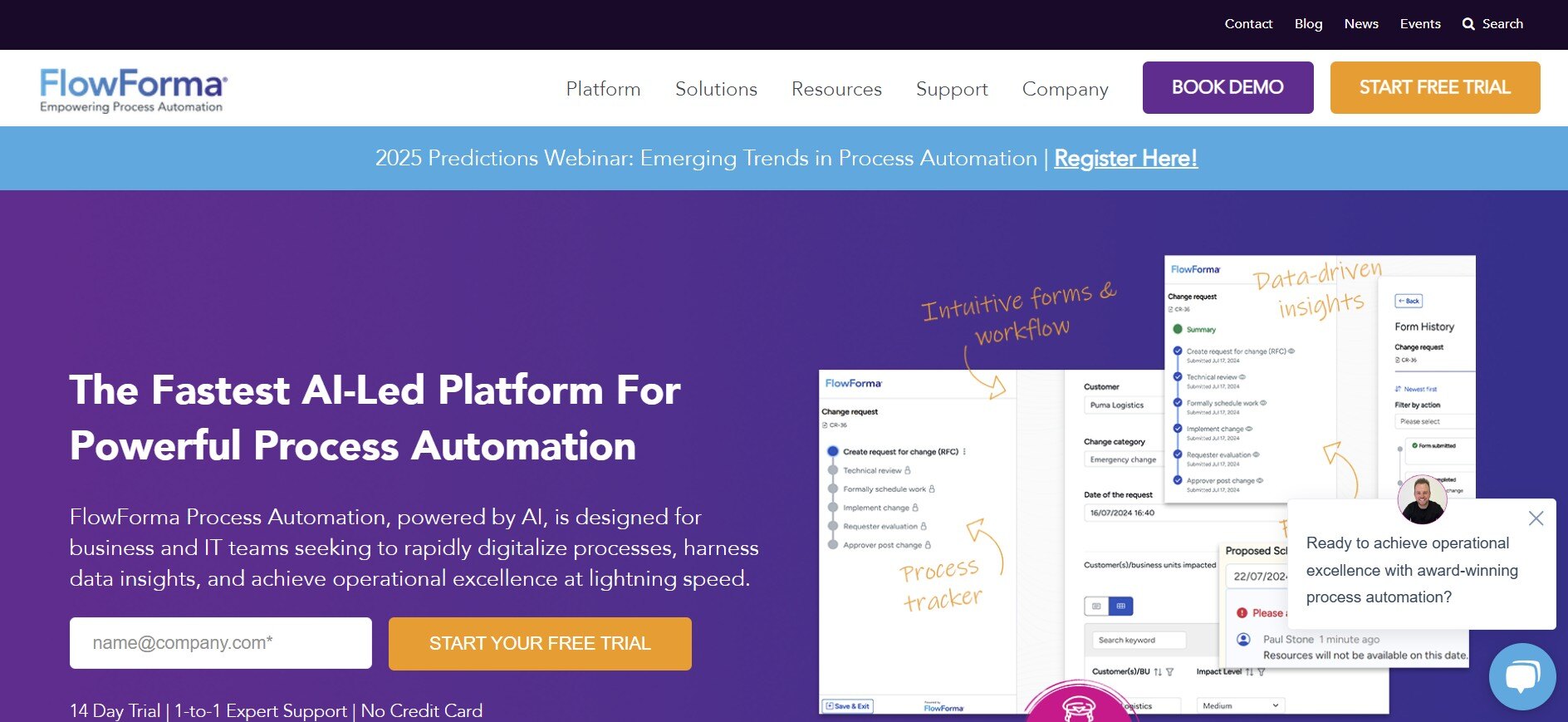
FlowForma Insights Dashboard: AI-driven process automation for seamless workflows
FlowForma is a powerful no-code AI process automation tool designed for enterprises that want to streamline workflows without depending on IT teams. Unlike traditional automation platforms, FlowForma combines AI workflow automation, business rules, document generation, and AI-powered decision-making, all within an easy-to-use, drag-and-drop interface.
One of its standout features is its AI-driven Copilot which analyzes workflow data and provides real-time process recommendations to improve efficiency. Businesses can also use its predictive analytics to forecast bottlenecks before they happen. FlowForma also integrates seamlessly with Microsoft 365, making it a natural choice for companies already using SharePoint and Teams.
2. UiPath
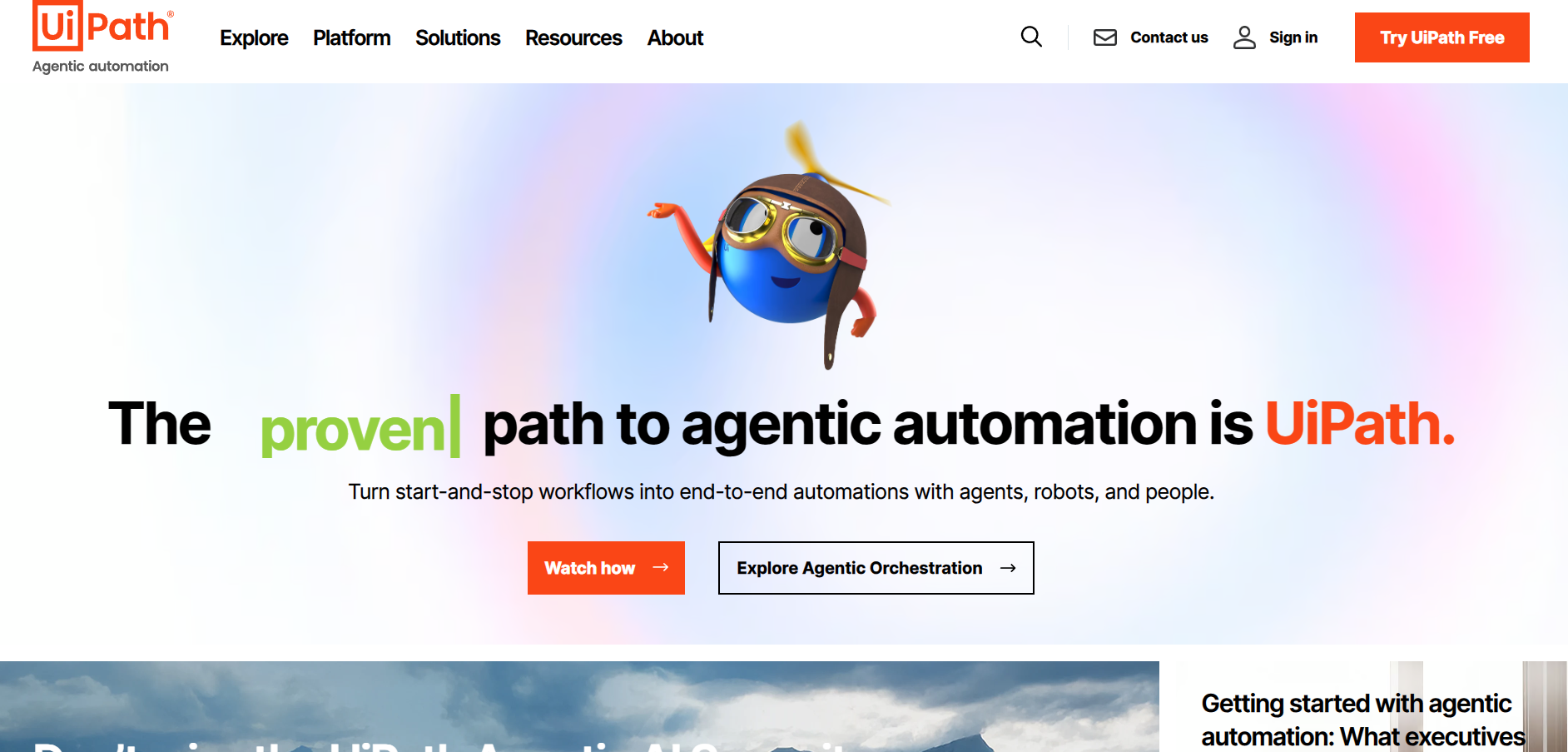
UiPath Agentic Automation: Transforming workflows with AI-driven bots and automation.
UiPath is an AI-driven RPA platform, offering end-to-end automation for businesses. Its AI-powered document understanding uses natural language processing (NLP) and computer vision to extract and process data from invoices, contracts, and emails.
Besides, the AI Center allows businesses to integrate pre-trained machine learning models or train custom AI models for more intelligent automation.
3. Automation Anywhere
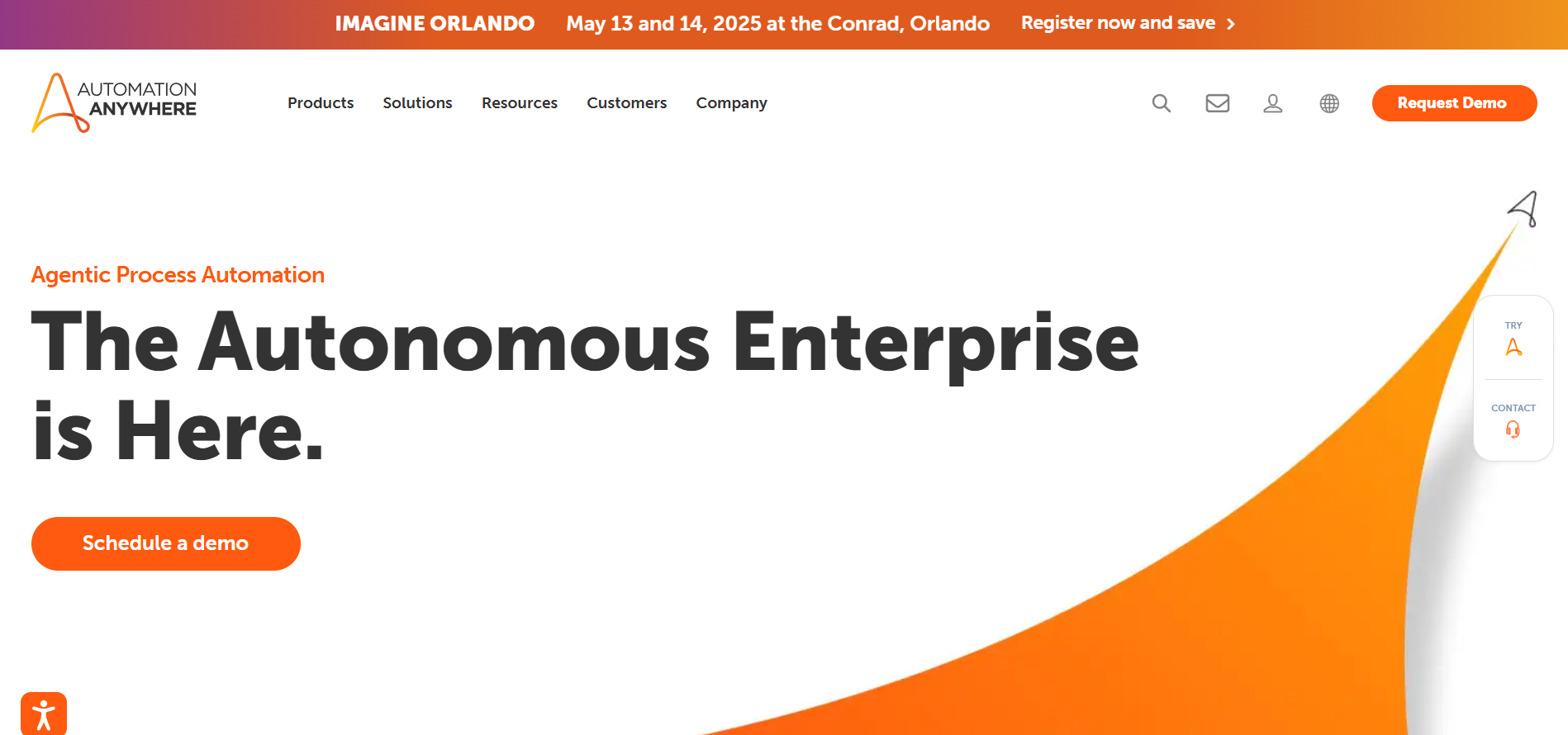
Automation Anywhere: AI-powered autonomous enterprise automation for business scalability.
Automation Anywhere uses IQ Bot technology that leverages AI and ML to interpret unstructured data from scanned documents, emails, and images, reducing the need for manual data entry. The platform also integrates Generative AI, allowing users to automate processes using natural language commands.
In addition, it has features like AI-powered chatbots and multi-cloud deployments.
4. Microsoft Power Automate
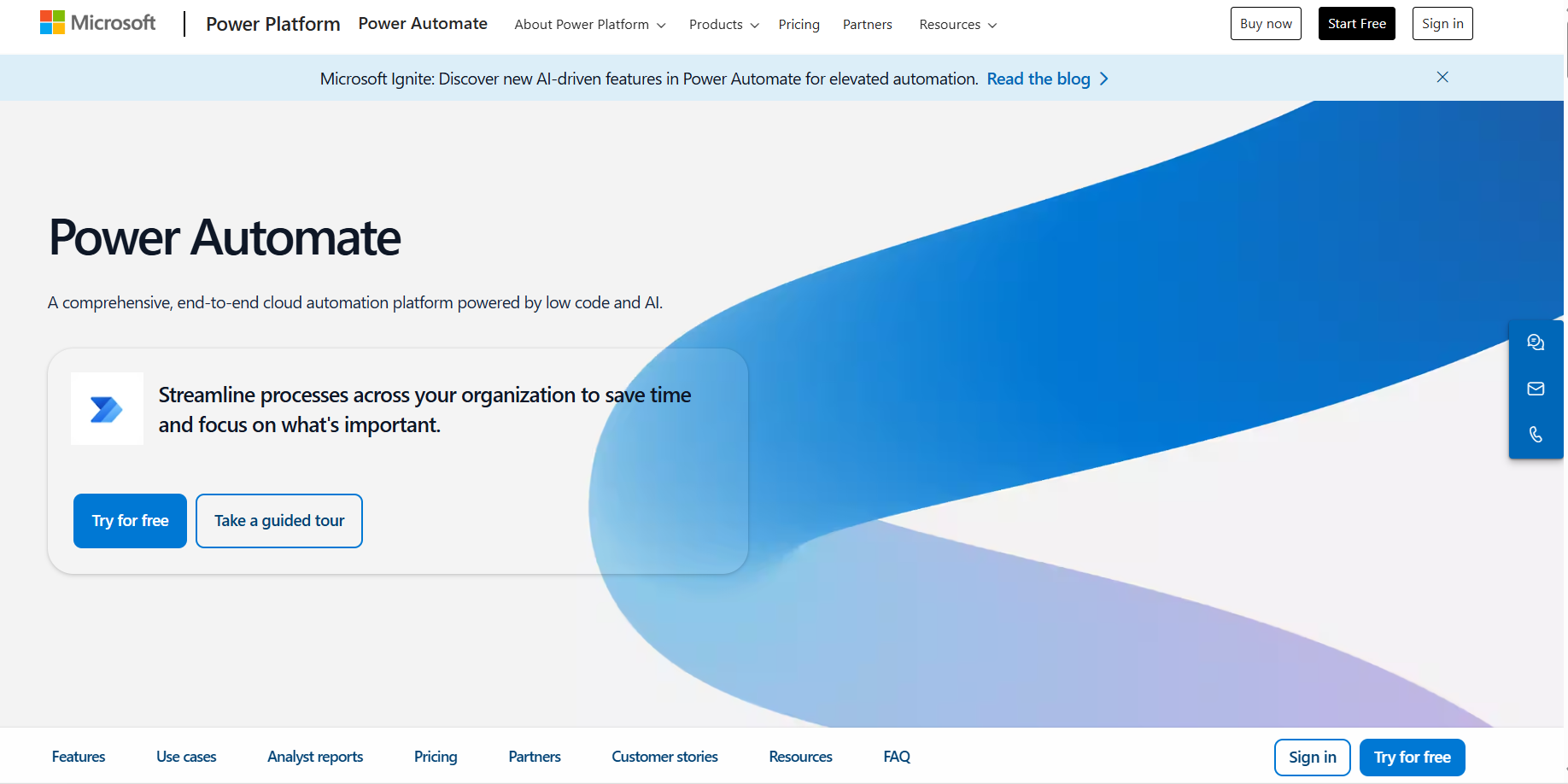
Microsoft Power Automate’s Homepage.
Microsoft Power Automate integrates artificial intelligence with low-code workflow automation. It connects with Microsoft 365, Dynamics 365, and Azure AI services, enabling organizations to automate a variety of business processes.
Besides, the tool’s AI Builder allows users to apply AI capabilities such as extracting text from documents, analyzing sentiment in emails, and automating decision-making processes.
5. Creatio

Creatio AI-Native No-Code Platform: Automating CRM and Business Workflows with AI-Powered Insights.
Creatio’s AI-powered process automation offers AI-assisted workflow design to automate sales, marketing, and customer service tasks.
Furthermore, the platform features predictive analytics to forecast customer behavior, smart recommendations for process optimization, and no-code/low-code automation.
6. Kissflow
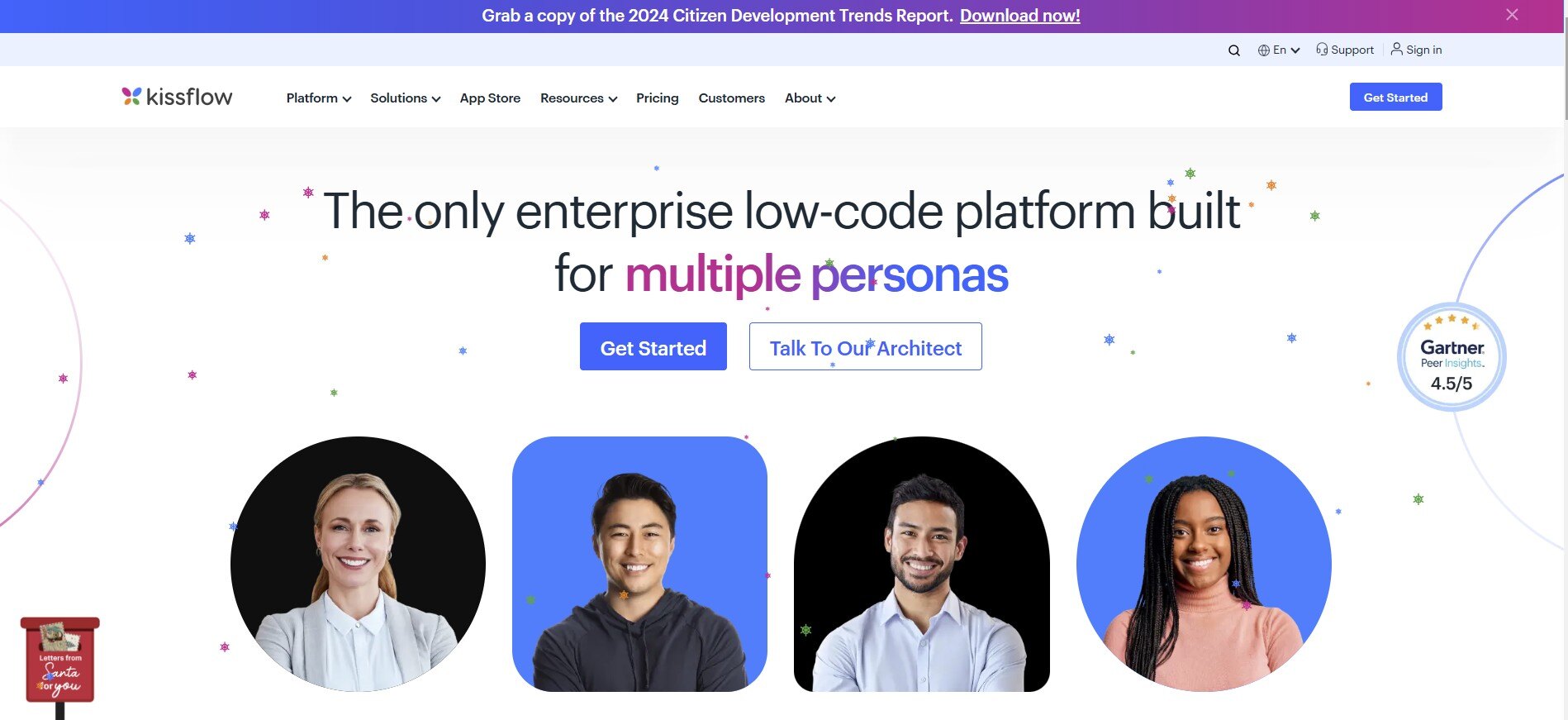
Kissflow Low-Code Automation: Simplifying workflows for multiple business users.
Kissflow provides AI-driven workflow automation for business process management (BPM), case management, and project management. Its AI features help businesses analyze process efficiency, predict bottlenecks, and recommend workflow improvements.
Kissflow’s AI tools also allow businesses to automate document approvals, HR onboarding, and procurement workflows.
7. Nintex

Nintex’s AI-Powered Workflow Automation
Nintex provides AI-powered process mapping that allows organizations to visualize workflows, identify inefficiencies, and automate repetitive tasks using bots. The platform also offers AI-assisted document automation, enabling businesses to auto-generate contracts, invoices, and reports. Additionally, the AI-powered Nintex Process Discovery tool identifies manual tasks suitable for automation.
Improve AI Process Automation and Boost Productivity with FlowForma
AI process automation offers businesses the opportunity to optimize workflows, reduce manual errors, and make data-driven decisions that improve overall efficiency.
Tools like FlowForma, which integrate AI with business process automation, provide a seamless solution for organizations looking to drive greater operational performance, digital transformation, and competitive advantage.
Book a demo or start your free trial to see how FlowForma can optimize AI Process Automation for your business.
 By
By 